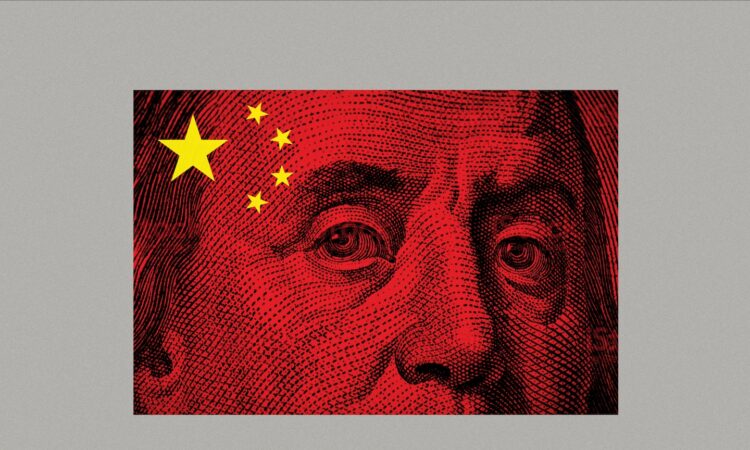
Would you like your retirement savings to be powering the CCP’s techno-totalitarian surveillance state?
These aren’t hypothetical questions. Millions of Americans have become financial backers of the CCP without knowing it. Their savings are funding companies that build weapons for China’s People’s Liberation Army as well as companies involved in the ongoing genocide in Xinjiang.
This month, the Biden administration took a first crack at the problem. In a long-awaited executive order, the president directed the Treasury Department to issue rules restricting some U.S. investment in Chinese companies working on artificial intelligence, semiconductors and quantum computing. This was a good first step, but it should not be the last.
Earlier this summer, alongside Rep. Raja Krishnamoorthi (Ill.), the ranking Democrat on the House Select Committee on the CCP, I began investigating major U.S. investment companies and venture capital firms for funding Chinese companies that the U.S. government has blacklisted because of national security concerns or the companies’ involvement in human rights abuses. What we’ve found so far is troubling.
Financial giants such as MSCI and BlackRock funnel U.S. money to companies that produce the CCP’s military aircraft, its aircraft carriers, its aerospace technology, its artillery shells and even its advanced nuclear technology. These firms are not alone. Investment in problematic Chinese companies is rampant across Wall Street and Silicon Valley.
We are quite literally funding our own potential destruction — and the executive order, while well-intentioned, won’t stop it. It is up to Congress to erect strong, enduring guardrails around outbound investment in China.
First, we must get a full accounting of the scale of this problem. The executive order contains a weak notification requirement for investments in a narrow list of technologies, but Congress must establish much broader transparency measures across technologies critical to national security. Free speech is not the only thing that disappears behind China’s Great Firewall — money trails do as well.
Second, we should not allow investments that support China’s military modernization, the CCP’s forced labor and genocide, or Beijing’s techno-totalitarian surveillance state. Because of the CCP’s strategy of military-civil fusion, this can be easier said than done. But the U.S. government already blacklists many of these companies and prohibits them from purchasing American technology. Why do we allow Wall Street to shovel money to them?
Third, we must address all capital outflows to China, public and private. This is the executive order’s biggest gap. It focuses only on “active” investments such as venture capital and private equity — only 17 percent of total U.S. capital investment in Chinese companies — but exempts public market products such as ETFs, mutual funds and exchange-listed stocks. We must address the remaining 83 percent by getting Americans’ retirement savings and pension funds, and the federal government’s Thrift Savings Plan, out of these problematic Chinese investments.
We should also delist and deindex Chinese companies that support the PLA, are on human rights blacklists, or deny U.S. investors basic protections, information and shareholder rights. There is no reason a genocidal communist regime with nothing but contempt for our system and its multilateral rules should enjoy the unfettered benefits of our markets and capital. Correspondingly, Chinese companies using variable interest entities (VIEs), structures set up specifically to skirt Chinese laws against foreign investment in sensitive technology companies — while providing none of the rights traditionally afforded to shareholders — must either meet basic shareholder protections or be removed from U.S. exchanges.
Fourth, we need to focus on sectors. We can’t play whack-a-mole imposing sanctions on individual companies that will inevitably change names and create subsidiaries to avoid restrictions. Nor will narrowly defining subcategories of technologies, as the Biden administration has done, suffice. Just look at the top PLA fighter-jet builder, Aviation Industry Corporation of China (AVIC). U.S. investors can’t hold AVIC securities, but AVIC subsidiaries are found in ETFs and mutual funds held by millions of Americans’ retirement accounts. Rather than creating an onerous, case-by-case review mechanism, we should give investors clear guidance over where they can and can’t invest, with an adequate but short glidepath to adjust.
Thankfully, the CCP has done some of our work for us. In its Made in China 2025 strategy and 14th Five-Year Plan, the CCP identified critical technology sectors it aspires to dominate — useful starting points for determining which sectors should be off-limits for U.S. investors.
Fifth and finally, we need to protect the stability of our financial system. The New York Federal Reserve should stress-test banks and asset managers according to specific scenarios, including an invasion of Taiwan, during which most U.S. investments in Chinese firms could lose most or all of their value. How much money are banks lending against these Chinese-related assets? How exposed are U.S. investors to dangerous, empty assets such as VIEs? Transparency measures will refine estimates, but it’s safe to say we have trillions of dollars’ worth of exposure to China, posing serious systemic risks to our financial system.
Given the gaps in President Biden’s executive order, as well as the impermanence inherent in any executive order, Congress has a duty to act. This is a complex issue, and bringing our allies along for the ride won’t be easy. But Wall Street needs to recognize that investments in malign Chinese firms create danger for our men and women in uniform, mortal peril for the targets of the CCP’s human rights abuses, and systemic risks for the global economy. That’s a deadly cocktail that the American people didn’t order — and should not be served.






